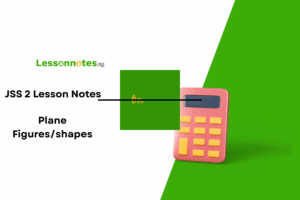Linear Inequalities JSS2 Mathematics Lesson Note
Download Lesson NoteTopic: Linear Inequalities
LINEAR INEQUALITIES
Inequality is an algebraic expression formed by replacing the equal sign of an equation with an inequality symbol. e.g. 7X + 5 = 16 (equation while 5X + 7 > 9 (inequality).
The following are commonly used in an inequality symbol.
V
SYMBOL MEANING REPRESENTATION
< LESS THAN
> GREATER THAN
≤ LESS THAN OR EQUAL TO
≥ GREATER THAN OR EQUAL TO
We often use inequality in our everyday life. We can write them as algebraic statements. For example, if the speed of a car is 250km/h or less, we can write this as S ≤ 250, where s represents speed.
GRAPH OF INEQUALITIES
A linear inequality has no square or higher power of the unknown. In other words, the power of the unknown is 1.
Example 1: 2x > 15 is a linear inequality in one variable. (X).
Solution:
2X > 10 [divide both sides by 2
2X/2 > 10/2
X = 5.
1 2 3 4 5 6 7 8
The empty circle at the end of the arrow shows that 5 is not included in the range
COMBINING INEQUALITIES
When combining inequalities (sometimes an unknown quantity obeys more than one inequality), these inequalities may be combined as one statement, the smallest number must be written first followed by the unknown, and finally the largest number, and vice-versa. For example, the diagram below shows that X can take any value from -2 to 3.
-6 -5 -4 -3 -2 -1 0 1 2 3 4
Hence the inequalities are X ≥ -2 and X < 3
But X ≥ -2 in reverse is written as a ≤ X and X < 3 can be combined as a single inequality as follows
-2 ≤ X ≤ 3.
Example 1:
-6 -5 -4 -3 -2 -1 0 1 2 3 4 5 6
X ≥ -1, X ≤ 5
-1 ≤ x ≤ 5
Example 2:
-5 -4 -3 -2 -1 0 1 2
X > -5, X ≤ 2
-5 < X ≤ 2






















